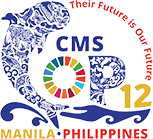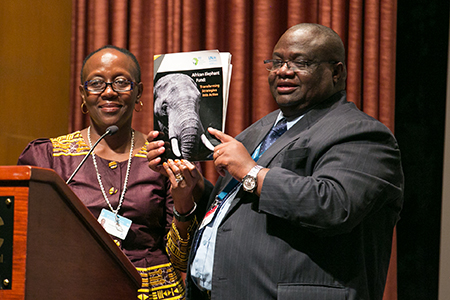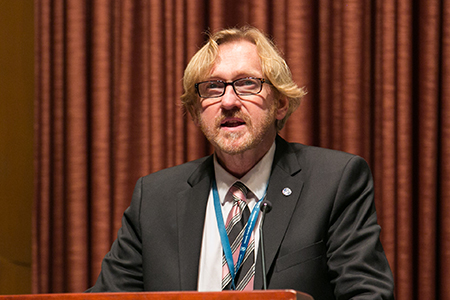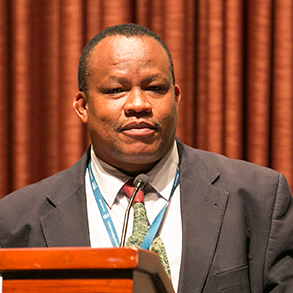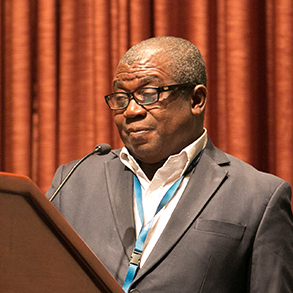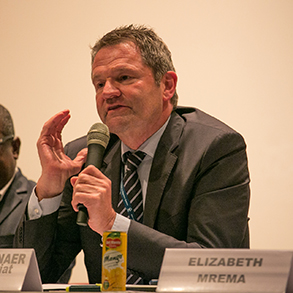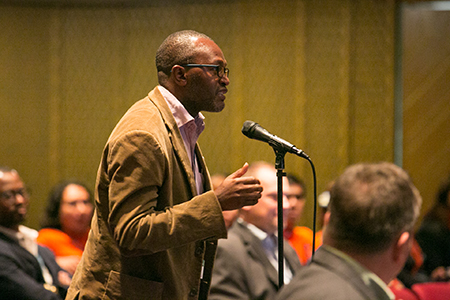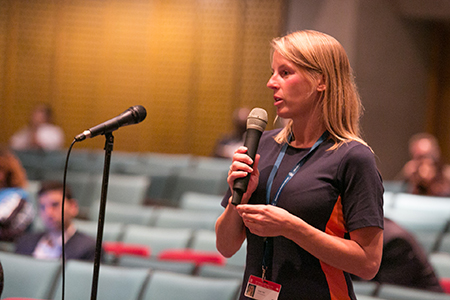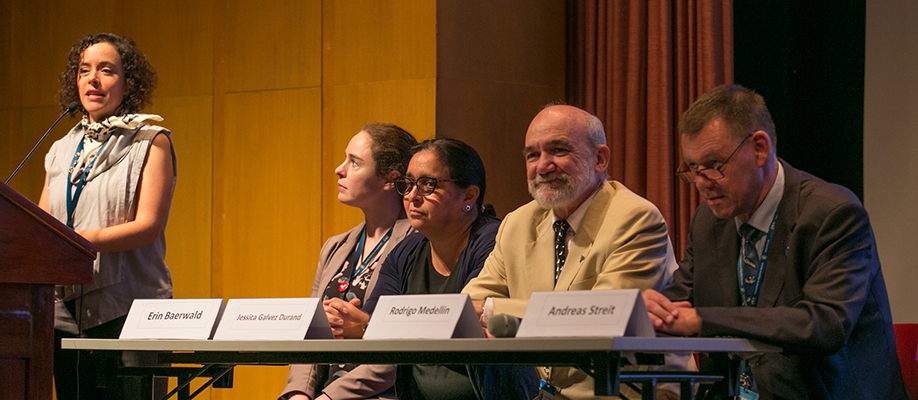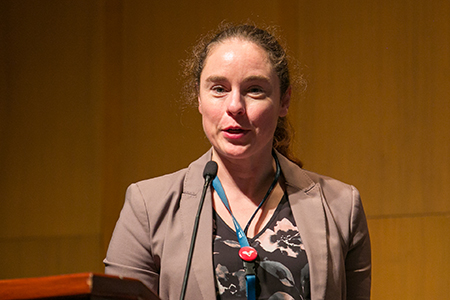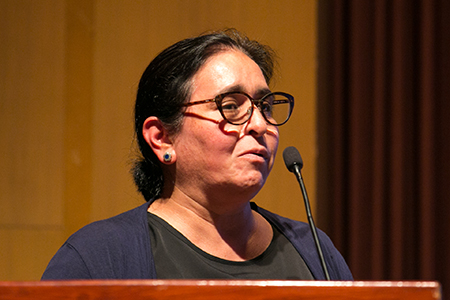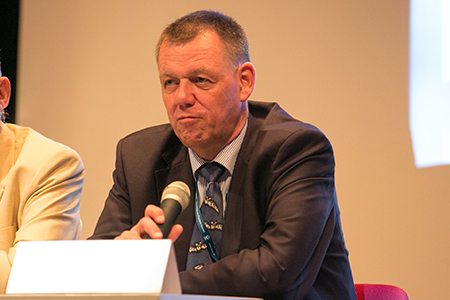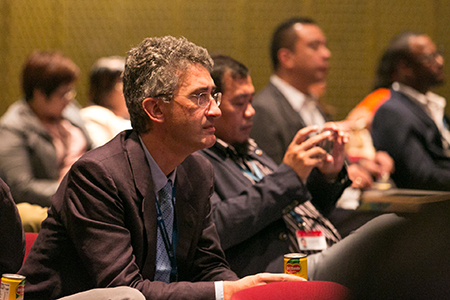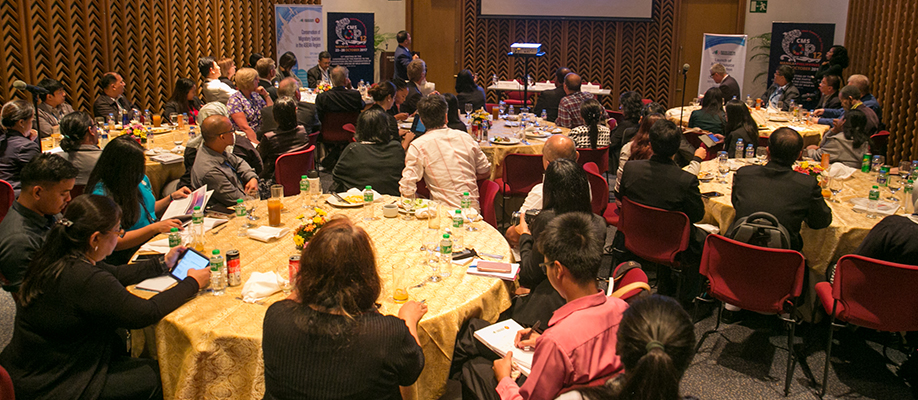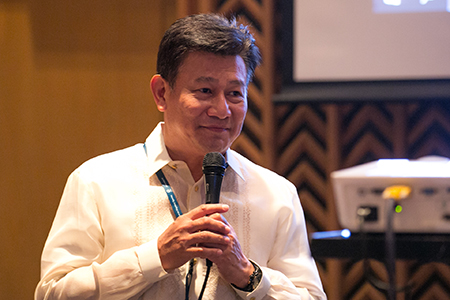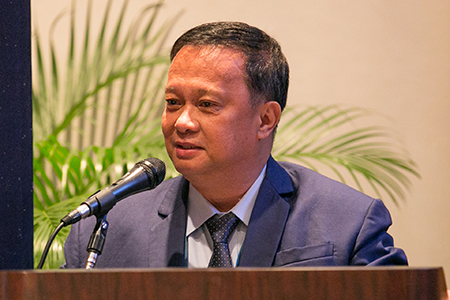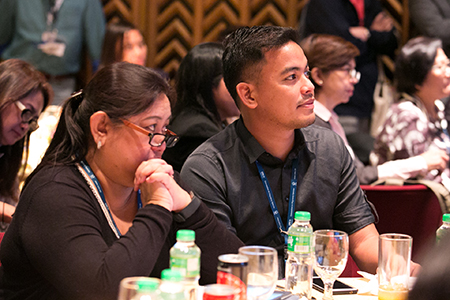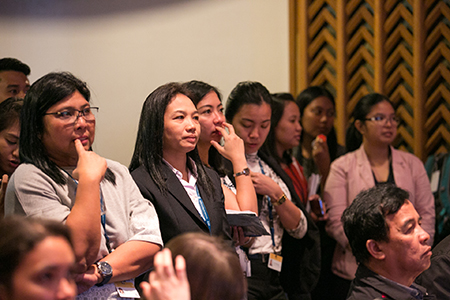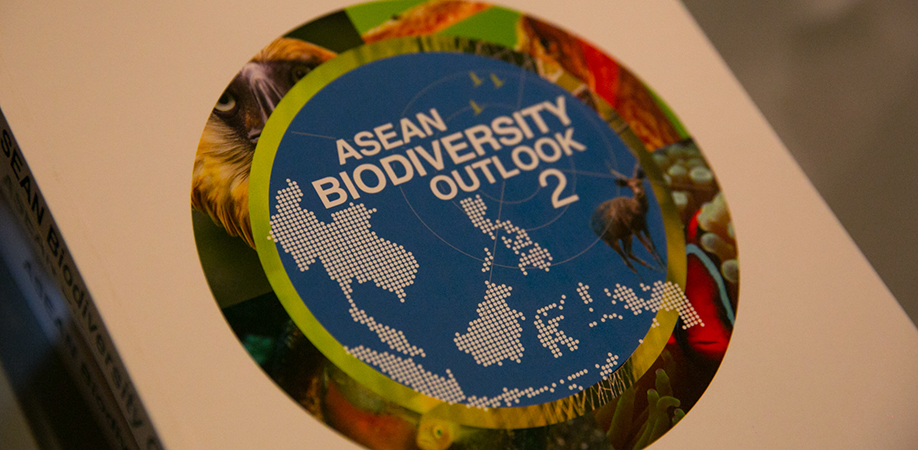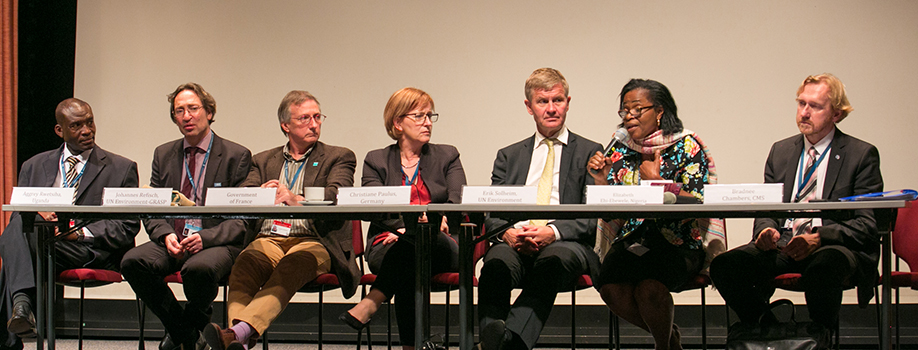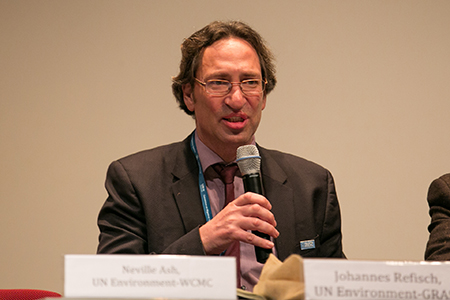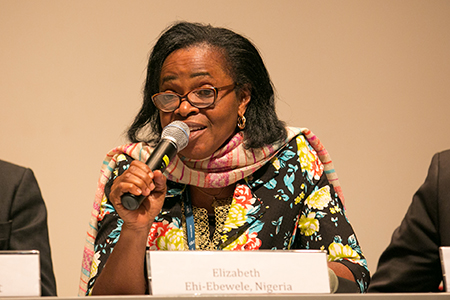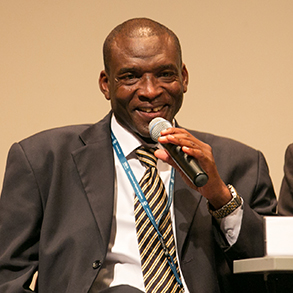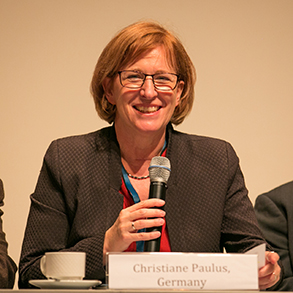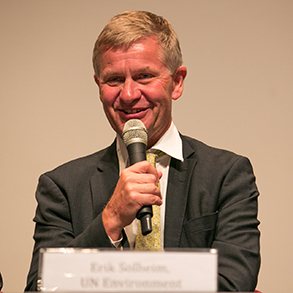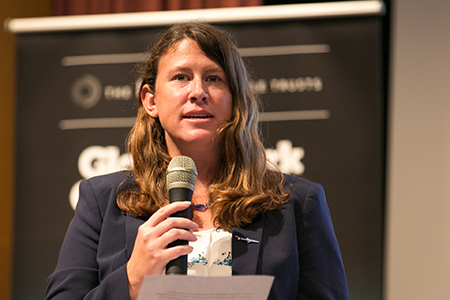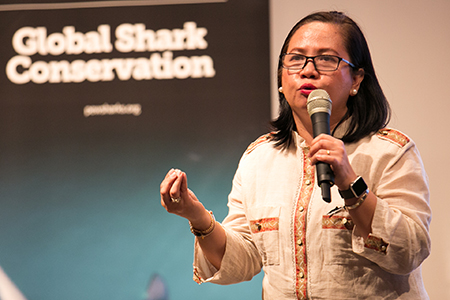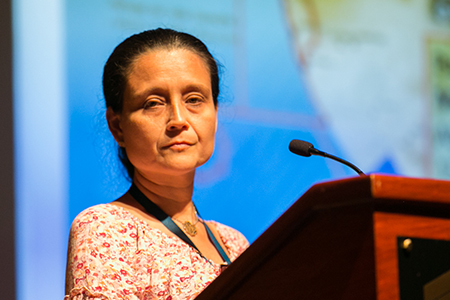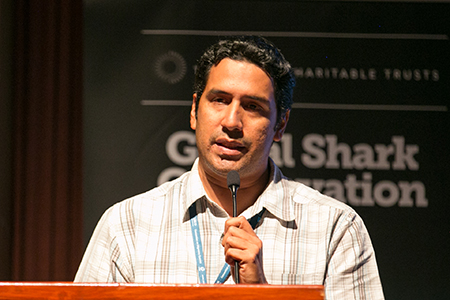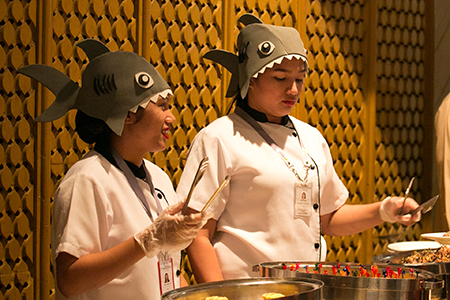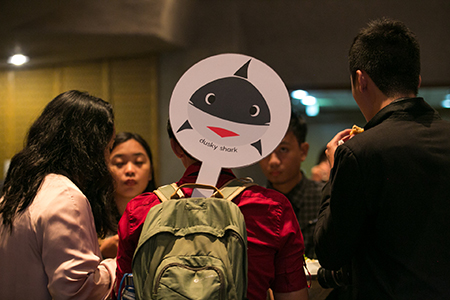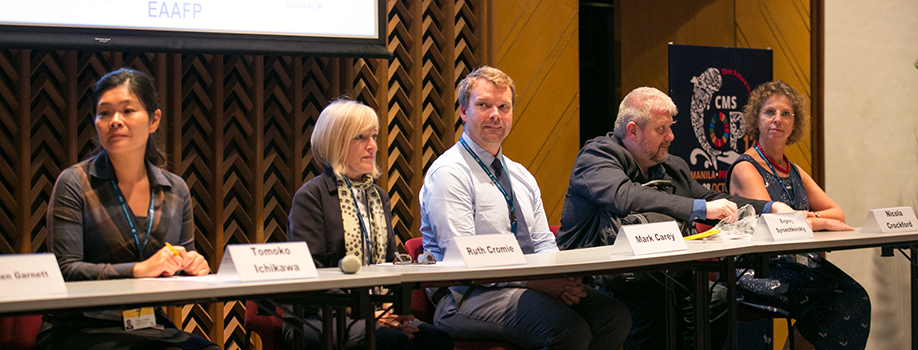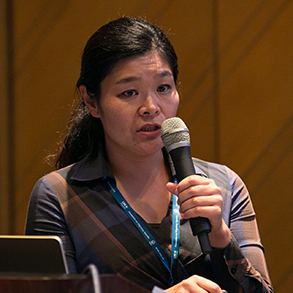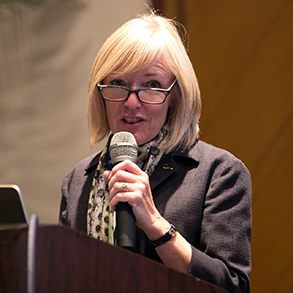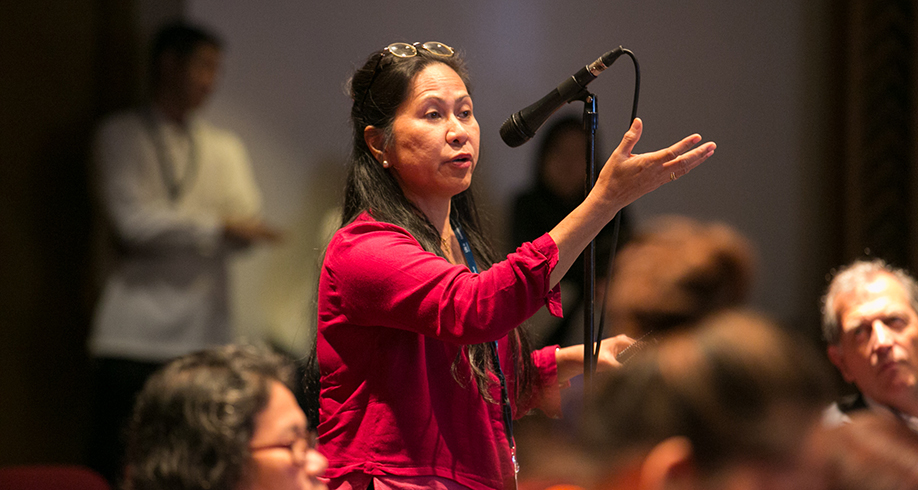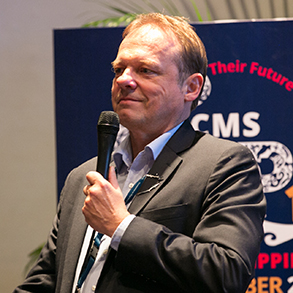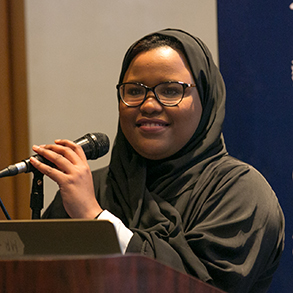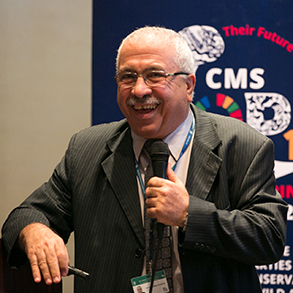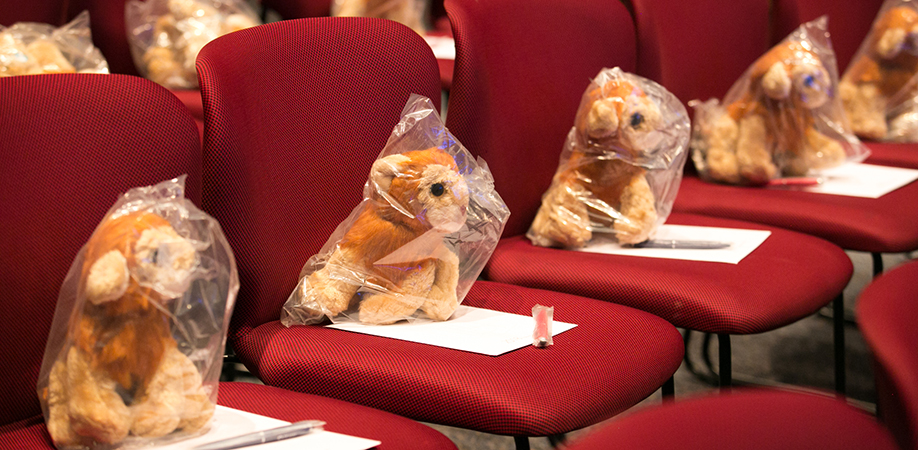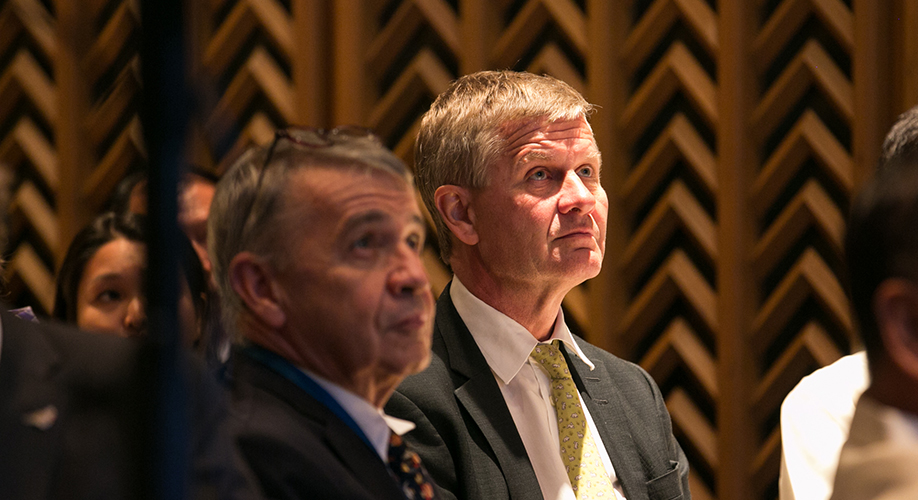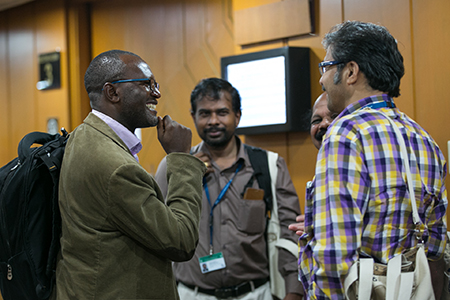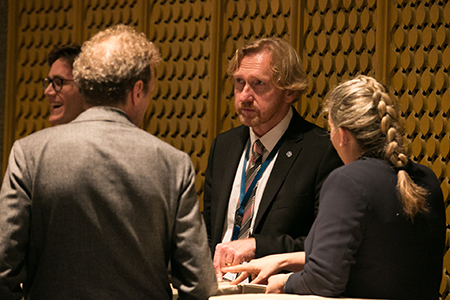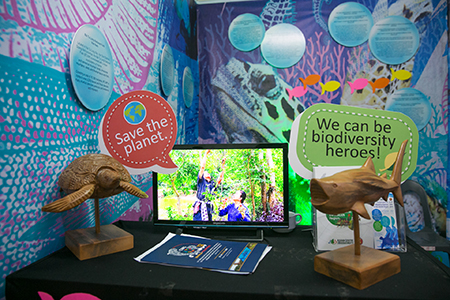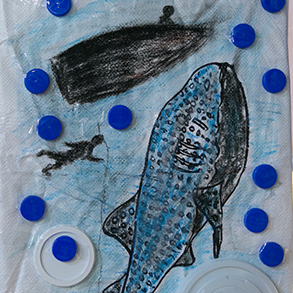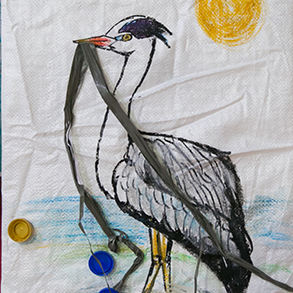Summary
The following events were covered by IISD Reporting Services on Wednesday, 25 October 2017:
- African Elephant Action Plan: Safeguarding Africa’s Elephants for Future Generations
- Green Energy, and Conservation of Migratory Bats
- Conservation of Migratory Species in the ASEAN Region
- The Great Apes Survival Partnership (GRASP) is Calling - Changing the Way We Do Great Ape Conservation in a Changing World
- International Icons: How Sharks Shape Lives Across the Globe
- Single Species Action Plans for Migratory Waterbirds in the East Asian-Australasian Flyway
- Protecting Migratory Species in the Middle East and North Africa Region
IISD Reporting Services, through its Earth Negotiations Bulletin on the Side (ENBOTS) Meeting Coverage, is providing daily web coverage from selected side events at CMS COP12.
Photos by IISD/ENB | Kiara Worth
For photo reprint permissions, please follow instructions at our Attribution Regulations for Meeting Photo Usage Page.
African Elephant Action Plan: Safeguarding Africa’s Elephants for Future GenerationsPresented by the African Elephant Fund (AEF) Secretariat and UN Environment
This session, moderated by Francisco Rilla, UN Environment, highlighted: ongoing activities of range state projects funded by the AEF on implementation of the African Elephant Action Plan (AEAP); lessons learned in implementation; and ways to strengthen CMS parties and African elephant range states’ collaboration on management of cross- border elephant populations.
Bradnee Chambers, CMS Executive Secretary, welcomed growing collaboration between African elephant range states on conservation of migratory elephants in the continent, including the Western African Memorandum of Understanding (MOU) signed in 2005. He stressed CMS Secretariat readiness to support and implement the AEAP in partnership with CITES, including through fundraising.
Patrick Omondi, Chair, AEF Steering Committee, launched the new AEF/UN Environment joint report, ‘African Elephant Fund: Transforming Strategies into Action.’ He highlighted good practices from AEF-funded projects in addressing challenges such as illegal killing and ivory trafficking, and human-elephant conflicts.
James Njogu, Kenya Wildlife Service, noted the African elephant range states' partnership is the main driver for strengthening implementation of the AEAP, and stressed the importance of synergies between CMS and CITES to scale up this initiative.
Kofi Nana Adu-Nsiah, Wildlife Division of the Forestry Commission, Ghana, emphasized engaging and raising awareness of local communities in implementing the AEAP through logistical support to monitor conservation status on the ground.
Tom de Meulenaer, CITES Secretariat, said it is essential for CMS to support and implement the AEAP as most of the listed actions are on “conserving” migratory elephants, a core business of CMS, as opposed to CITES’ mandate on trade.
Elizabeth Mrema, UN Environment, celebrated the launch of the new report, highlighting its benefits for other range states working on conserving migratory elephants.
In the ensuing discussion, several CMS parties expressed full support for funding and implementing the AEAP, and underlined the importance of ensuring ownership and participation of non-state actors, in particular the private sector and local communities. Omondi concluded the session by urging CMS parties to adopt and implement the AEAP.
Panel speakers (L-R): Bradnee Chambers, CMS Executive Secretary; Patrick Omondi, Chair, AEF Steering Committee; James Njogu, Kenya Wildlife Service; Kofi Nana Adu-Nsiah, Wildlife Division of the Forestry Commission, Ghana; Tom de Meulenaer, CITES Secretariat; and Elizabeth Mrema, UN Environment.
Elizabeth Mrema, UN Environment, and Patrick Omondi, Chair, AEF Steering Committee, launched the new report, ‘African Elephant Fund: Transforming Strategies into Action.’
Bradnee Chambers, CMS Executive Secretary, noted duplication “should be avoided” between CMS and CITES.
James Njogu, Kenya Wildlife Service, said “adopting the AEAP in CMS COP12 means more donors and partnerships.”
Kofi Nana Adu-Nsiah, Wildlife Division of the Forestry Commission, Ghana, highlighted that “efforts to conserve African elephants have been difficult without the AEF.”
Tom de Meulenaer, CITES Secretariat, said the AEF has been successful in reaching a broader range of donors and stakeholders to move the AEAP forward.
Participants engage in an interactive discussion
Contact:
-
Francisco Rilla | francisco.rilla@unep.org
More Information:
Green Energy, and Conservation of Migratory BatsPresented by CMS Secretariat and UNEP/EUROBATS
This event focused on current threats to migratory bat species caused by wind energy production and the potential for the proposed CMS Appendix II listing of four hoary bats (Lasiurus spp.) to encourage needed research and catalyze protection.
Andreas Streit, Executive Secretary, UNEP/EUROBATS, urged adoption of the proposed listing, saying “it’s time to start working on bat conservation within CMS.”
Rodrigo Medellin, National Autonomous University of Mexico, emphasized the need for model species to help understand wind energy impacts on bats; described a potential 90% decline for hoary bats over the next 50 years without adequate action; said that waiting until bats are listed will be too late; and urged support for the proposed listing.
Jessica Galvez-Durand, National Forest and Wildlife Service, Peru, noted that three of the four proposed species occur in Peru. She outlined reasons for the proposed listing, including, inter alia: more legal protection; creating an opportunity to develop a regional action plan; promoting collaboration and synergies in the region and with UNEP/EUROBATS; and increased possibilities to promote sustainable development while mitigating impacts of wind energy.
Erin Baerwald, University of Regina, Canada, reviewed increasing trends of bat fatalities in different regions, noting that data suggest fatality rates of 800,000 bats per year for US and Canada. She stressed that conservation measures for wind facilities need to consider: proper siting; curtailment of turbines; acoustic deterrents; ultraviolet lighting; management of cumulative effects; and coordinated international protections and regulations.
In discussion, participants noted: purchasing energy from bird- and bat-friendly energy producers as a conservation strategy; the importance of post-construction monitoring; documenting ecosystem services provided by bats to encourage conservation and mitigation measures; and mapping tools and strategies.
Panel speakers (L-R): Moderator Alejandra Goyenechea, Defenders of Wildlife; Erin Baerwald, University of Regina, Canada; Jessica Galvez-Durand, National Forest and Wildlife Service, Peru; Rodrigo Medellin, National Autonomous University of Mexico; and Andreas Streit, Executive Secretary, UNEP/EUROBATS
Rodrigo Medellin, National Autonomous University of Mexico, called bats the “proverbial nocturnal canary in the mine,” telling us that wind energy is desirable, but we need to make it more environmentally friendly.
Erin Baerwald, University of Regina, Canada, noted that wind energy turbines are killing prime breeding age adults that come from large wind catchment areas.
Jessica Galvez-Durand, National Forest and Wildlife Service, Peru, said the goal for Peru is to expand the wind energy market while integrating bat conservation.
Andreas Streit, Executive Secretary, UNEP/EUROBATS, emphasized the importance of post-construction monitoring for bat mortality at wind energy facilities.
Participants during the event
Materials on display
Contact:
-
Alejandra Goyenechea | agoyenechea@defenders.org
Conservation of Migratory Species in the ASEAN Region
Presented by the Association of Southeast Asian Nations (ASEAN) Centre for Biodiversity (ACB)
This event, moderated by Sheila Vergara, ACB, covered activities on the conservation of migratory species in the ASEAN Region, the reduction of marine litter, and the ACB Resource Mobilization Strategy.
Tomoko Ichikawa, East Asian-Australasian Flyway Partnership (EAAFP), presented on the flyway, which supports the highest proportion of threatened migratory water bird species in the world, and on the Flyway Site Network, a set of internationally important sites for conservation of water birds.
Christiane Paulus, Federal Ministry for the Environment, Nature Conservation, Building and Nuclear Safety, Germany, underscored the importance of avoiding marine plastic debris to prevent negative impacts on migratory marine species and other marine life.
Roberto Oliva, Executive Director, ACB, presented on the ASEAN Heritage Parks, home to important migratory species such as the Chinese egret. He launched the ACB Resource Mobilization Strategy, to bring citizens and the private sector together for species conservation.
Erik Solheim, Executive Director, UN Environment, said we need to simplify UN language and develop “simple, attractive messages to include more people,” and work with the business sector to develop synergies and further environmental causes.
Ramon Paje, Vice President for Asia Pacific, UN Environment Assembly (UNEA), expressed hope for achieving a “pollution-free planet,” focusing on the upcoming UNEA.
View of the room during the event
Ramon Paje, Vice President for Asia Pacific, UN Environment Assembly, said humans are having a disastrous impact on biodiversity, but efforts like the ACB can help.
Erik Solheim, Executive Director, UN Environment, noted that “there is a lot of good news,” with important meetings and world leaders focusing on environmental action.
Christiane Paulus, Federal Ministry for the Environment, Nature Conservation, Building and Nuclear Safety, Germany, said there is considerable evidence that marine litter leads to large economic losses in the tourism and fisheries sectors.
Roberto Oliva, Executive Director, ACB, expressed that the uniqueness, diversity and outstanding value of certain ASEAN national parks and reserves deserve the highest recognition as conservation areas.
Participants during the event
Contact:
-
Sheila Vergara | svergara@aseanbiodiversity.org
More Information:
The Great Apes Survival Partnership (GRASP) is Calling - Changing the Way We Do Great Ape Conservation in a Changing WorldPresented by UN Environment/GRASP and the Government of France
This side event, moderated by Neville Ash, UN Environment/World Conservation Monitoring Center, brought together key GRASP partners to discuss new initiatives and ideas to promote the Partnership and great ape conservation.
Noting that in a fast and changing world, “we need to think out of the box” regarding conservation, Johannes Refisch, UN Environment/GRASP, stressed that GRASP, with its more than 100 partners, including member nations, research institutions, UN agencies, conservation organization and private sector supporters, can facilitate cross-border and cross-sectorial approaches.
François Lamarque, Ministry of Environment, Energy and Sea, France, reiterated his country’s support towards GRASP, noting that ongoing cooperation will be continued and strengthened in the years to come.
Underscoring that GRASP is “a very special organization,” crossing the various sectors and facilitating collaboration, Christiane Paulus, Federal Ministry for the Environment, Nature Conservation, Building and Nuclear Safety, Germany, announced that her country will support two new projects, namely on transboundary cross river gorilla conservation in Nigeria and Cameroon via a transboundary biosphere reserve, and on conflict-sensitive conservation of eastern lowland gorillas in the Democratic Republic of Congo.
Stressing that funding is the biggest constraint in conservation efforts in the region, Elizabeth Ehi-Ebewele, Federal Ministry of Environment, Nigeria, remarked that poaching, habitat degradation and deforestation have made gorilla populations in the Nigeria-Cameroon border region critically endangered.
Aggrey Rwetsiba, Chair, GRASP Executive Committee, Uganda, emphasized the need to focus on local communities, noting that “unless grassroots people in their poverty see the value in the conservation efforts, all the investments will be wasted.”
Gilles Biver, Ministry for Sustainable Development and Infrastructure, Luxembourg, announced that his country will support GRASP projects, deriving the financial resources from climate funds and provide voluntary contribution to the CMS Gorilla Agreement.
Erik Solheim, Executive Director, UN Environment, focused on the need for a stronger and better narrative and the necessity to involve local communities. He stressed that “we need to tell better, not boring stories on the environment,” adding that policing is an inadequate measure and the involvement of local communities in conservation efforts invaluable.
Noting that gorillas have been listed in CMS Appendix I since the beginning, Bradnee Chambers, CMS Executive Secretary, provided an overview of the CMS Gorilla Agreement, emphasizing that GRASP and CMS have strong overlapping objectives, and announcing the proposal for collaboration between the two institutions under a specific legal framework and programme.
Panel speakers (L-R): Aggrey Rwetsiba, Chair of the GRASP Executive Committee, Uganda; Johannes Refisch, UN Environment/GRASP; François Lamarque, Ministry of Environment, Energy and Sea, France; Christiane Paulus, Federal Ministry for the Environment, Nature Conservation, Building and Nuclear Safety, Germany; Erik Solheim, Executive Director, UN Environment; Elizabeth Ehi-Ebewele, Federal Ministry of Environment, Nigeria; and Bradnee Chambers, Executive Secretary, CMS
Johannes Refisch, UN Environment/GRASP, stressed the need to “think beyond our comfort zone” regarding conservation, allowing for new projects and ideas to protect the great apes.
Elizabeth Ehi-Ebewele, Federal Ministry of Environment, Nigeria, highlighted the importance of financial pledges, stressing that funding is the single largest constraint in conservation efforts in the area.
Noting that in Uganda tourism-generated income related to gorillas and chimpanzees is shared with the local communities, Aggrey Rwetsiba, Chair, GRASP Executive Committee, Uganda, underscored that “the locals will be shooting if anyone tries to hurt a gorilla.”
Noting that GRASP is “not only a duty, but an initiative supported by her heart,” Christiane Paulus, Federal Ministry for the Environment, Nature Conservation, Building and Nuclear Safety, Germany, emphasized that in a conservation environment that is changing, cross-sectoral approaches are essential.
Using the example of the well-organized and regulated gorilla-related eco-tourism activities in Rwanda, Erik Solheim, Executive Director, UN Environment, emphasized that development around it “makes the local communities the first to protect the gorillas.”
Participants during the event
A GRASP video presentation stressed the relationship between humans and great apes
Contact:
-
Johannes Refisch | johannes.refisch@unep.org
More Information:
International Icons: How Sharks Shape Lives Across the GlobePresented by Marine Wildlife Watch of the Philippines, Save Philippines Seas and the Pew Charitable Trusts
This side event, moderated by Anna Oposa, Save Philippine Seas, showcased the importance of whale sharks in the Philippines, focusing on the ecotourism activities around the species in Donsol, and highlighted the other shark and ray proposals for listing in the CMS Appendices in COP12.
Josephine Alcantara-Cruz, Mayor of Donsol, Philippines, described how the town of Donsol has been transformed over a period of 20 years from a “sleeping town” into a vibrant, international eco-tourism destination, contributing almost half a billion pesos to the national economy and transforming local livelihoods. She underscored main challenges, including limited resources, relevant legislation development and adaptation to climate change, emphasizing that intensive local conservation efforts are inadequate since the species is migratory. Alcantara-Cruz urged the international community to help protect this iconic species, including its uplisting to CMS Appendix I and introduced a video ‘Migratory Sharks: Sustaining Communities Globally,’ which portrayed the interactions between whale sharks and humans.
KerriLynn Miller, The Pew Charitable Trusts, introduced other shark species in need of global cooperation and management, and addressed the angel shark, the white spotted wedgefish, the common guitarfish, the blue shark and the dusky shark, proposed for listing in the CMS Appendices.
Danny Rueda Córdova, Galapagos National Park, Ecuador, presented research on the hammerhead, Galapagos, silky, blacktip and tiger sharks in the Galapagos region, both in the national park and beyond, including defining their routes to allow for management decisions.
Julia Cordero, Ministry of Environment, Ecuador, presented research on the oceanic manta rays in the region. Noting the importance of the Plata Island, which presents the biggest congregation of oceanic manta rays with 2,600 individuals, she addressed research activities, inter alia: photo laser identification; tagging with telemetry; studies of reproductive behaviour and eating habits; and mapping of movements, including through the installation of acoustic devices.
A video discussing the importance of sharks is shown during the event
Addressing the conservation of shark and rays as a global priority, KerriLynn Miller, The Pew Charitable Trusts, stressed that “their future is our future.”
Stressing that poverty rates in Donsol dropped from 67% to 40% as a result of ecotourism, Josephine Alcantara-Cruz, Mayor of Donsol, Philippines, emphasized that she “cannot imagine when the whale shark will no longer visit us.”
Focusing on the oceanic manta ray, Julia Cordero, Ministry of Environment, Ecuador, urged the international community to increase the efforts for its protection.
Danny Rueda Córdova, Galapagos National Park, Ecuador, emphasized the importance of studying the movement and routes of shark species.
Contact:
-
Anna Oposa (Moderator) | annaoposa@gmail.com
More Information:
Single Species Action Plans for Migratory Waterbirds in the East Asian-Australasian FlywayPresented by the Government of Australia, BirdLife Australia, BirdLife International, and the East Asian-Australasian Flyway Partnership (EAAFP)
This session, moderated by Stephen Garnett, CMS Scientific Councillor for Birds, Australia, centered on: sharing experience and knowledge from the implementation of existing migratory waterbird single species action plans (SSAPs) in the EAAF; and galvanizing action and coordination of the continued implementation of SSAPs in range states.
Tomoko Ichikawa, EAAFP, presented four SSAPs on: spoon-billed sandpiper; black-faced spoonbill; Chinese crested tern; and Siberian crane. She stressed that the SSAPs have been successful in bringing together range states and other partners to address species-specific challenges.
Ruth Cromie, Wildfowl and Wetlands Trust, presented the Baer’s pochard SSAP, and underlined major threats, including habitat loss and unsustainable harvesting due to: poisoning; inadequate site protection and management; bycatch in fishing nets; lack of public awareness; and excessive use of pesticides and fertilizers. She urged CMS parties to adopt its action plan during CMS COP12.
Mark Carey, Department of the Environment and Energy, Australia, explained that the Far Eastern curlew SSAP aims to: restore its population to a positive growth rate for at least three generations; support research and monitoring of climate change impacts; and assess the risk of disturbance impacts.
In the ensuing discussion, moderated by Connie Warren, BirdLife Australia, participants discussed: the value of SSAPs as opposed to habitat-based action plans; the SSAP approach as a tool to raise awareness at the political level; and the African-Eurasian Vultures Multi-species Action Plan for bringing together range states with a set of single species action plans.
Panel speakers (L-R): Tomoko Ichikawa, EAAFP; Ruth Cromie, Wildfowl and Wetlands Trust; Mark Carey, Department of the Environment and Energy, Australia; Evgeny Syroechkovskiy, Ministry of Natural Resources and Ecology, Russia; and Nicola Crockford, BirdLife International
Tomoko Ichikawa, EAAFP, noted the SSAPs are important instruments for implementing coordinated measures to restore and maintain migratory waterbird species in favorable conservation status.
Mark Carey, Department of the Environment and Energy, Government of Australia, said the Far Eastern Curlew Task Force supports range states in developing national action plans.
Ruth Cromie, Wildfowl and Wetlands Trust, said, “What we need is individual commitment to improve coordination on conserving waterbirds.”
Participants engage in an interactive dialogue
Contact:
-
Connie Warren | connie.warren@birdlife.org.au
More Information:
Protecting Migratory Species in the Middle East and North Africa RegionPresented by the Government of the United Arab Emirates and the International Fund for Animal Welfare (IFAW)
This event, moderated by Matt Collis, IFAW, focused on the activities carried out by IFAW and various governments in the Middle East and North Africa region (MENA) to conserve migratory species.
Nahla Alnoobi, United Arab Emirates (UAE), summarized national efforts to protect migratory species, with 43 protected areas and various agreements for conservation, including joining CMS last year. She said efforts have focused on capacity building and awareness raising campaigns, including addressing passengers at national airports and youth empowerment campaigns.
Ralf Sonntag, IFAW, talked about their work in the MENA region, particularly on sharks, noting that 51% of all species are endangered. He said including them in CITES or CMS is not enough and, noting IFAW support, stressed that actions need to be implemented.
Akram Darwich, IFAW, said they are working in MENA to reduce the trade of illegal species, because the region is both a trade and migration bottleneck, attracting illegal hunters, who use these routes to achieve illegal trade. He said that education and awareness campaigns can help reduce these pressures.
Matt Collis, IFAW, closed the session by giving an overview of their global work. He said they aim to work across the chain of wildlife crime, including source and transit countries to maximize their impact, and gave examples of the breadth of projects and how they relate to CMS.
View of the room during the event
Ralf Sonntag, IFAW, highlighted shark killing as “a huge problem,” and emphasized working together internationally and adopting the shark proposals.
Nahla Alnoobi, UAE, noted her country’s focus on capacity building, including more than 40 workshops and special training courses on biodiversity.
Akram Darwich, IFAW, underscored that education programmes can empower people to take positive action towards animals.
Contact:
-
Matt Collis (IFAW) | mcollis@ifaw.org
More Information:
Around the Venue
Erik Solheim, Executive Director, UN Environment
Delegates speak informally
Bradnee Chambers, CMS Executive Secretary, speaks with delegates
